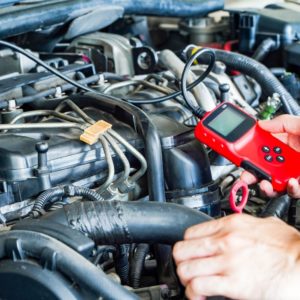Fuel pressure is one of the most important parameters influencing engine performance. On direct injection vehicles, the fuel pressure regulator (also known as the fuel pressure control valve) regulates the fuel pressure coming out of the high-pressure pump.
Code P228C is a generic trouble code that’s related to a fault in your fuel pressure regulator 1.
What Does the P228C Code Mean?
Diagnostic trouble code P228C stands for “Fuel Pressure Regulator 1 Exceeded Control Limits – Pressure Too Low.” The code applies to diesel-powered vehicles.

Your vehicle’s PCM is in control of your electronic fuel pressure regulator. The PCM uses data from the fuel pressure sensor to adjust the voltage of the pressure regulator when the vehicle is in motion. Battery voltage and ground signals are utilized to regulate a servo motor (in the fuel pressure regulator) that actuates a valve that ensures the desired level of fuel pressure is attained in any given condition.
A P228C will be stored if the actual fuel pressure regulator 1 control circuit voltage exceeds a specified parameter and the actual fuel pressure is not within specifications.
Note: The definition of code P228C can differ according to the vehicle manufacturer. Check the appropriate repair manual or repair database for the exact code definition.
What Are the Common Causes of the P228C Code?
- High-pressure fuel pump (with internal regulator) malfunction
- Low-pressure fuel pump failure
- Faulty fuel pressure sensor
- Fuel line and fuel injector leaks
- Wiring problems
- Worn or damaged camshafts

What Are the Common Symptoms of the P228C Code?
- Illuminated check engine light
- Vehicle refuses to start
- Poor engine performance
- Engine stalling
- Decreased fuel economy
How to Diagnose the P228C Code
DTC P228C can be logged on a variety of vehicles. However, this doesn’t mean there is one solution that’ll work for all trouble codes.
Advanced technical knowledge and skills are needed to conduct automotive repairs. In most cases, it’s best to take your vehicle to a certified mechanic to get an accurate diagnosis.
Here’s a video that may give you a better idea of what the diagnostic procedure might involve:
How to Fix the P228C Code
The process of clearing a P228C code may vary depending on the vehicle’s year, make, and model. Therefore, it’s important to have vehicle-specific repair information before attempting any fixes.
You may enlist the services of a professional or attempt to do the repairs yourself. Whichever route you choose, we recommend brushing up on your auto repair knowledge by consulting your vehicle’s repair manual or looking up vehicle-specific information from an online repair database.
Any information provided on this Website is for informational purposes only and is not intended to replace consultation with a professional mechanic. The accuracy and timeliness of the information may change from the time of publication.















